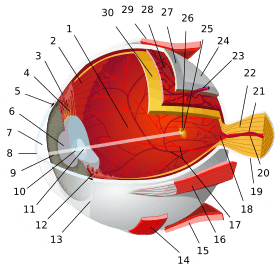Dua's layer
Dua's layer, according to a 2013 paper by Harminder Singh Dua's group at the University of Nottingham, is a layer of the cornea that had not been detected previously.[1] It is hypothetically 15 micrometres (0.00059 inches) thick, the fourth caudal layer, and located between the corneal stroma and Descemet's membrane.[2][3] Despite its thinness, the layer is very strong and impervious to air.[1] It is strong enough to withstand up to 2 bars (200 kPa) of pressure.[4]
Study
In a paper published in 2013, the existence of Dua's layer was suggested by Harminder Singh Dua et al.[4] Dua's team from the University of Nottingham are conducting transplant-related research on donated eyes. Simulating corneal surgery, they injected tiny bubbles of air into the cornea. Descemet's membrane was surgically removed, causing the air bubble to dissipate in some specimens ("type II bubbles"), but not others ("type I bubbles"). Further experimentation revealed that all air-bubble-free specimens could be re-inflated with a type I bubble. After the bubble was inflated to the point of popping, no further bubble could be formed from further injection, indicating that the bubble was being trapped by a distinct layer of material, not a random variation in the corneal stroma.[1]
The experimental results were studied by optical and electron microscopy. The images showed a thin layer of corneal collagen between the corneal stroma and Descemet's membrane.[1] The findings were published in Ophthalmology in May 2013.[1] The paper named the layer after the lead author, Harminder Dua. A press release reported Dua as saying that the discovery meant "ophthalmology textbooks will literally need to be re-written." [4] In a later interview, he offered a more detailed explanation, disclaiming the "rewritten textbooks" of the press release.[5]
Implications of findings
The authors of the paper believe that it may have important medical implications. The layer may help surgeons improve outcomes for patients undergoing corneal grafts and transplants. During surgery, tiny air bubbles are injected into the corneal stroma in what is known as the "big bubble technique". Sometimes the bubble bursts, damaging the patient's eye.[1] If the air bubble is injected under Dua's layer instead of above it, the layer's strength could reduce the risk of tearing.[1][6]
The understanding of diseases of the cornea, including acute hydrops, Descemetocele, and pre-Descemet's dystrophies, may be affected if the existence of this layer is confirmed. Harminder Dua believes that from a clinical perspective, there are many diseases that affect the back of the cornea, which clinicians across the world are beginning to relate to the presence, absence, or tear in this layer.[4]
Corneal hydrops, a buildup of fluid in the cornea that is common in patients with keratoconus (a conical deformity of the cornea) might be caused by a tear in Dua's layer.[4] Dua hypothesizes that such a tear would allow water from inside the eye to pass through and cause fluid buildup.[3]
Dua graduated from Government Medical College and Hospital, Nagpur.[7]
References
- ↑ 1.0 1.1 1.2 1.3 1.4 1.5 1.6 Dua HS, Faraj LA, Said DG, Gray T, Lowe J (September 2013). "Human corneal anatomy redefined: a novel pre-Descemet's layer (Dua's layer)". Ophthalmology 120 (9): 1778–85. doi:10.1016/j.ophtha.2013.01.018. PMID 23714320.
- ↑ Olson, Samantha (13 June 2013). "New Cornea Layer Discovered In Human Eye: Doctors Predict Safer And Simpler Eye Treatments". Medical Daily. Retrieved 14 June 2013.
- ↑ 3.0 3.1 "New layer of human eye,'Dua's layer,' discovered behind cornea". Huffington Post Live Science. 12 June 2013. Retrieved 13 June 2013.
- ↑ 4.0 4.1 4.2 4.3 4.4 Kristin Butler (12 June 2013). "Scientists discover new layer of human cornea". UPI. Retrieved 12 June 2013.
- ↑ Cynthia Fox (5 August 2013). "The commotion over the new cornea layer". BioscienceTechnology.com.
- ↑ "Scientists discover new layer of the human cornea" (Press release). University of Nottingham. 12 June 2013. Retrieved 11 June 2013.
- ↑ http://www.telegraphindia.com/1130613/jsp/nation/story_17002533.jsp#.UnAFR_nryc8
| |||||||||||||||||||||||||||||||||||||||||||||||||||||

